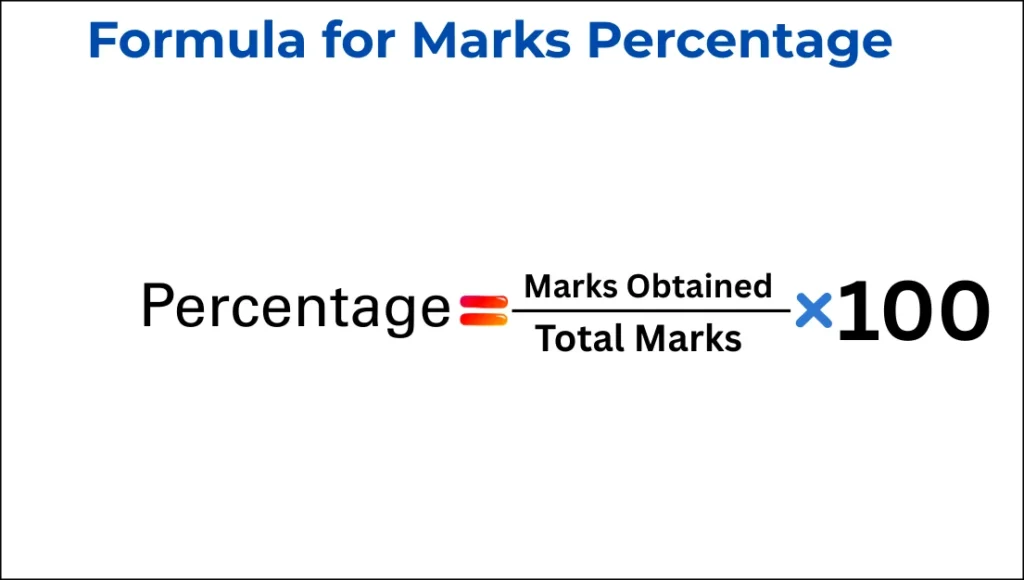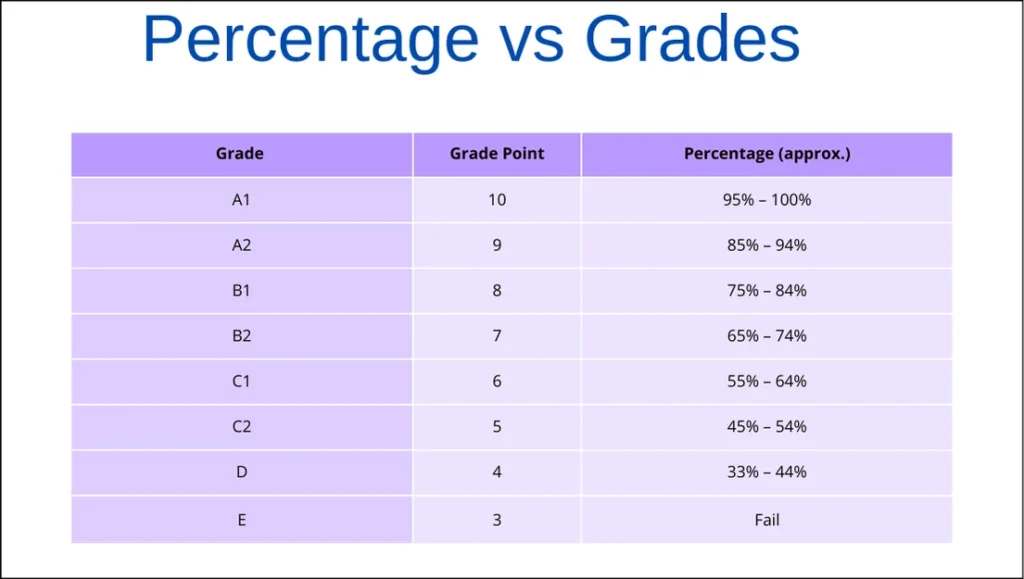Marks Percentage Calculator
Calculating percentage from marks is one of the most common tasks, whether in school, college, or professional exams. A marks percentage calculator helps students, parents, and teachers easily find out results without confusion. Instead of doing long manual calculations, you can quickly get the percentage of your total marks using simple formulas or ready-to-use online calculators.
What is Percentage?
The word “percentage” comes from the Latin term “per centum,” which means “per hundred.” Percentage is a way of expressing a number as a fraction of 100.
For example:
- 50% means 50 out of 100.
- 75% means 75 out of 100.
- 100% means full marks or complete.
In exams, percentage is the ratio of marks obtained to the total marks, multiplied by 100.
Formula for Marks Percentage
The simple formula to calculate percentage from marks is:Percentage= Percentage=(Total MarksMarks Obtained)×100
This formula works for any subject, test, or exam.

Example Calculations
- Suppose you scored 350 marks out of 500:
Percentage =(500350)×100=70%
- If a student got 720 marks out of 900:
Percentage=(900720)×100=80%
- For 275 marks out of 400:
Percentage =(400275)×100=68.75%
These examples show how easily percentages can be calculated.
Why Use a Marks Percentage Calculator?
While the formula is simple, doing it for multiple subjects, large numbers, or repeated calculations can be tiring. That is where a marks percentage calculator helps.
Benefits include:
- Saves time.
- Ensures accuracy.
- Easy for multiple subjects.
- Helps compare performance quickly.
Types of Percentage Calculations Students Need
- Single subject percentage—Marks obtained in one subject vs. total marks.
- Total exam percentage – Sum of all subjects’ marks vs. total marks.
- CGPA to Percentage conversion—useful for universities.
- Weighted percentage – For courses where subjects have different weightage.
Step-by-Step Guide to Calculating Percentage
While the formula to calculate percentage is short, many students often get confused when applying it in real exam scenarios. Let’s break it into simple steps anyone can follow:
Step 1: Write down marks obtained
This is the score you got in the exam. For example, 350 marks.
Step 2: Write down the total marks
This is the maximum you could score on the exam. For example, 500 marks.
Step 3: Divide obtained marks by total marks
Using the example: 350/500=0.70
Step 4: Multiply the result by 100
0.70×100=70%
That’s it! You have your percentage.
Percentage for Multiple Subjects
Often, students have to calculate their overall percentage across multiple subjects. Here’s the method: Total Percentage=(Sum of total marksSum of all marks obtained)×100
Example with 5 subjects:
| Subject | Marks Obtained | Total Marks |
|---|---|---|
| Math | 80 | 100 |
| Science | 70 | 100 |
| English | 65 | 100 |
| Hindi | 60 | 100 |
| Social Studies | 75 | 100 |
- Total Obtained = 80 + 70 + 65 + 60 + 75 = 350
- Total Marks = 500
Percentage= 500350×100=70%
This is how report card percentages are usually calculated.
Weighted Percentage Calculation
Sometimes, not all subjects carry equal marks weightage. For example, in professional exams or higher education, practicals or projects may carry more importance than other subjects.
Here’s how you calculate weighted percentage: Weighted Percentage=Sum of (Total Marks × Weightage)Sum of (Marks Obtained × Weightage)×100
Example:
- Subject A: 80/100, weightage 40%
- Subject B: 150/200, weightage 60%
Step 1: Multiply marks with weightage.
- A: 80 × 0.40 = 32
- B: 150 × 0.60 = 90
Step 2: Add them.
32 + 90 = 122
Step 3: Total weightage percentage = 122% out of 100% = 81.33% final percentage.
CGPA to Percentage Conversion
Many schools, colleges, and universities use CGPA (Cumulative Grade Point Average) instead of percentages. Converting CGPA to percentage is often required during job applications or for higher studies abroad.
In India, most boards, like CBSE, follow this formula: Percentage= Percentage=CGPA×9.5
Example:
- If your CGPA = 8.2
Percentage=8.2×9.5=77.9%
Different universities may use slightly different formulas, so always check the rules of your institution.
Common Mistakes in Calculating Percentage
Students often make errors while converting marks to percentages. Let’s list the common mistakes so you can avoid them:
- Dividing wrong values—Students sometimes divide total marks by obtained marks instead of vice versa. Always remember: marks obtained ÷ total marks.
- Forgetting to multiply by 100—Without this step, you only get a fraction, not a percentage.
- Mixing subject percentages directly—always find the total marks first, then calculate the overall percentage.
- Rounding errors—Always round only at the final step, not in the middle.
Why Percentage Matters?
Understanding and calculating percentages is not just for passing exams—it has real-life importance.
- Admissions—Schools, colleges, and universities use percentages to shortlist students.
- Job applications—Employers often ask for academic percentages.
- Competitive exams – Eligibility criteria are usually set based on percentage.
- Scholarships—Higher percentages increase your chances of getting financial help.
- Self-analysis—Students can track improvement across terms.
Real-Life Applications of Marks Percentage
Percentage is not just useful in exams. It is applied in many areas of academic, professional, and everyday life. Let’s look at some real-life uses:
In Education
- Results & Report Cards – Schools and colleges always mention final results in percentage.
- Cut-off Marks for Admissions – Universities often set eligibility criteria such as “Minimum 60% marks required.”
- Scholarships—Many organizations demand at least 75%–85% marks for scholarship eligibility.
In Jobs & Career
- Recruitment Eligibility—Most companies in India require graduates to have at least 60% in their degree.
- Competitive Exams – UPSC, SSC, Banking, and State exams all set minimum qualifying percentages.
- Career Growth—Better percentages in academics often help in building a strong resume.
In Daily Life
- Financial Decisions—Interest rates, discounts, and savings are all calculated in percentages.
- Performance Tracking – Whether fitness goals or business targets, success is measured in percentages.
- Sports Analysis – Batting average in cricket, shooting accuracy, or ball possession in football is written in percentage.
Clearly, learning to calculate marks percentage is not only helpful for students but for almost everyone at some stage.
Extended Examples for Better Clarity
Here are more solved examples to make percentage calculation crystal clear.
Example 1: Simple Exam
A student scores 410 marks out of 600. Percentage=600410×100=68.33%
Example 2: Large Number Exam
Out of 1200 total marks, you got 1005 marks. Percentage=12001005×100=83.75%
Example 3: University Exam with Multiple Subjects
| Subject | Obtained | Total |
|---|---|---|
| Physics | 72 | 100 |
| Chemistry | 68 | 100 |
| Mathematics | 85 | 100 |
| Computer Science | 90 | 100 |
| English | 70 | 100 |
- Total obtained = 72 + 68 + 85 + 90 + 70 = 385
- Total marks = 500
Percentage=500385×100=77%
Percentage vs Grades
Sometimes, exam results are given in grades instead of exact marks. Students need to convert grades to percentages for applications.

Here’s a simple reference (example for the CBSE system):
| Grade | Grade Point | Percentage (approx.) |
|---|---|---|
| A1 | 10 | 95% – 100% |
| A2 | 9 | 85% – 94% |
| B1 | 8 | 75% – 84% |
| B2 | 7 | 65% – 74% |
| C1 | 6 | 55% – 64% |
| C2 | 5 | 45% – 54% |
| D | 4 | 33% – 44% |
| E | Below 3 | Fail |
Always verify with your school/university conversion table, since each system may vary.
Advantages of Using a Marks Percentage Calculator
- Speed—Instant calculation saves time.
- Accuracy—No chance of human error.
- Convenience – Works on mobile or computer anytime.
- Comparison—Helps compare performance across exams.
- Versatility—Many calculators allow GPA, CGPA, weighted marks, and even percentage increase/decrease calculations.
Frequently Asked Questions (FAQs)
How do I calculate percentage if my results are in decimals?
If you got 325.5 marks out of 450: 325.5/450×100 =72.33%
Can I calculate a percentage without using a calculator?
Yes. The formula only uses division and multiplication. For example, out of 400 marks, if you score 280:
Divide: 280 ÷ 400 = 0.70
Multiply by 100 → 70%
How do I convert my grade into a percentage?
Multiply your CGPA or grade point by the conversion factor (e.g., 9.5 in CBSE).
Why is percentage important in exams?
It summarizes your performance in a simple number, making it easy to compare among students during admissions or job applications.
What if I get 0 marks in one subject?
You must add all marks together (including 0) before dividing by total marks. That subject will pull down your overall percentage.
Conclusion
A marks percentage calculator is one of the simplest yet most useful tools for students, teachers, and parents. By applying the straightforward formula: Percentage=Total MarksObtained Marks×100
You can calculate your performance in any subject or exam. Whether you use manual calculation or an online tool, percentage acts as a universal language of performance measurement.
